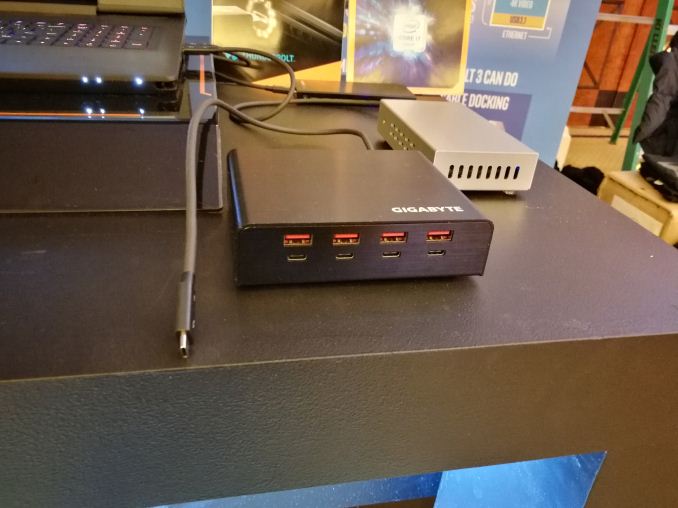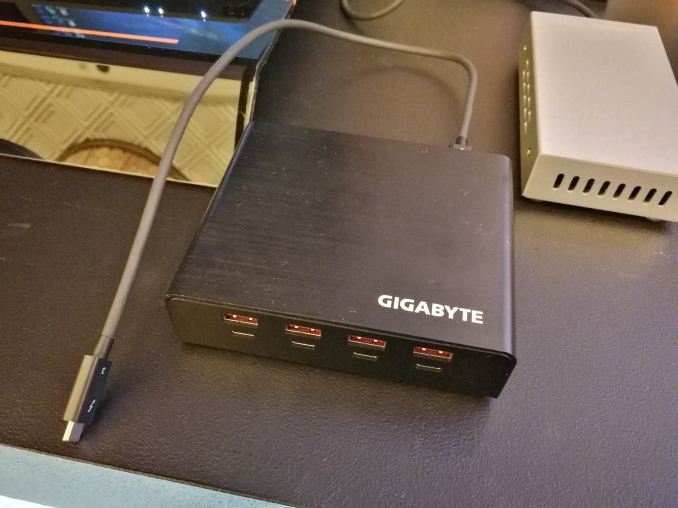CES 2017: GIGABYTE’s Thunderbolt 3 to 8x USB 3 Dock
by Ian Cutress on January 12, 2017 11:00 AM EST- Posted in
- Systems
- Gigabyte
- USB 3.0
- Trade Shows
- USB 3.1
- Thunderbolt 3
- CES 2017

In some ways, Thunderbolt 3 is opening up a new world of connectivity. Having 40 Gbps of bandwidth to play with, along with a number of key mobile devices turning to it as their only source of connectivity, will in some form or another drive the hub and peripheral market beyond what TB1 and TB2 did. That being said, the market is still a bit slow: products are announced, but are region limited or produced in small quantities while the rest of the market develops the functionality to use it. So when we see a good trinket, it can be exciting if it reaches retail.
So enter a GIGABYTE dock that takes Thunderbolt 3 and splits the PCIe lanes between eight USB 3 ports, four using Type-A and four using Type-C. I must confess that I didn’t confirm if these were USB 3.0 ports at 5 Gbps or USB 3.1 at 10 Gbps, which if it was using the latter I would suspect employs a PLX switch and a set of ASMedia ASM1142 controllers to provide the functionality, but would also mean that a user could not pummel the maximum data rate of each port when all were in use. If I were to be cynical, this could just be a single controller and a hub, which would make the unit very disappointing.
At present this unit did not support power passthrough or daisy chaining, however we did suggest both to GIGABYTE as a feature, especially the latter with the ability to daisy chain storage devices. Given that this unit doesn’t require external power, it is at least taking the power required from the TB3 connector. Something like this would go a long way to helping users that rely on a single port out of their device at least. Now admittedly there are a variety of TB3 docks coming to the market offering all sorts of port sets, and these docks typically start at around $150 to get anything more than a couple of USB ports, an Ethernet port and a card reader. We’ll wait and see how GIGABYTE decides to play in this space.













15 Comments
View All Comments
Siress - Sunday, September 3, 2017 - link
There seems to be a real issue with quality control regarding the use of the TB interface. I suspect it's just a complexity issue, a strategic decision to sell more of their legacy devices for the time being, or if they really are under appreciating how much the market wants this sort of device modularity. It seems that Intel themselves are the one's preventing some of these devices from hitting the market; source: https://twitter.com/sephr/status/81788301116523315...The_Assimilator - Friday, January 13, 2017 - link
Could we rather just get more USB ports on the actual motherboard IO panel or via headers, instead of Thunderbolt which has so few applications it's about as useful as FireWire?surt - Friday, January 13, 2017 - link
But that wouldn't be elegant! You can't seriously propose that a computer might have more than one hole in its case?nowayandnohow - Wednesday, January 18, 2017 - link
Kind of hard to find a mainstream MB that doesn't have 6+ USB ports these days, and why invest in "old" tech? USB maxes out at 5GBit, so why opt for that when you can have one USB-C with 40 GBits?zilesija - Friday, January 13, 2017 - link
my neigbour recently purchased Infiniti FX SUV just by part time work from a laptopsee more http://atmoney.tk